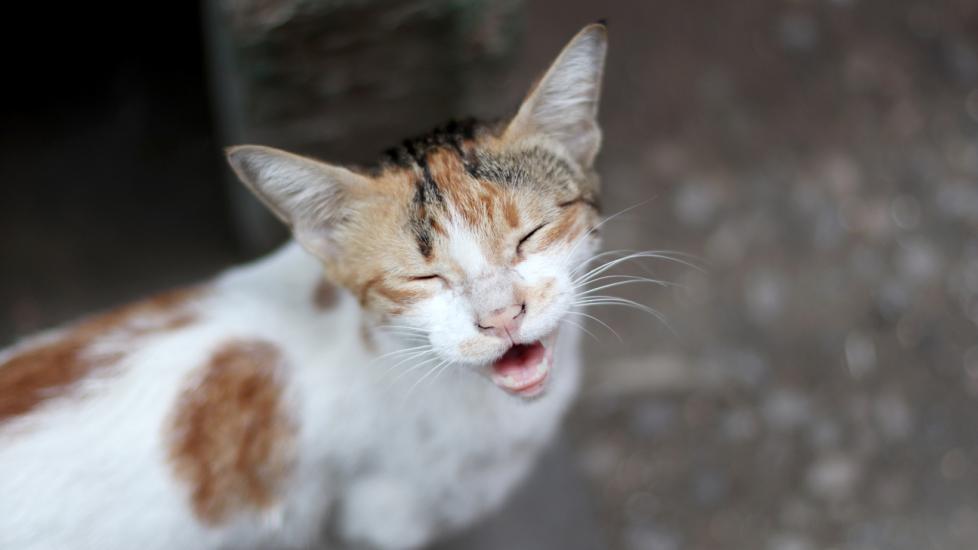Laryngeal Paralysis in Cats
What is Laryngeal Paralysis in Cats?
Laryngeal paralysis is an upper-airway disorder where the cartilages of the larynx do not open and close normally. The larynx, or voice box, is the opening to the trachea (windpipe) that allows your cat to meow, but also acts as a gatekeeper between the mouth and the lungs. When the cat inhales, muscles pull the larynx open from two sides and then they relax when the cat exhales.
In cats with laryngeal paralysis, these muscles do not function properly, so when the cat inhales, the airway does not pull open, creating an airway obstruction.
Laryngeal paralysis in cats is a medical emergency because if left untreated, airway obstruction can quickly progress to suffocation and death. If suspect laryngeal paralysis in your cat, contact your nearest animal hospital immediately.
Health Tools
Not sure whether to see a vet?
Early symptoms can be subtle and difficult to identify, but may include:
- Noisy breathing
- Raspy meow/voice change
- Coughing
- Lethargy
- Increased respiratory rate and/or increased respiratory effort
- Trouble swallowing
- Weight loss
As the disease progresses, a cat will have a hard time breathing (panting, expanding chest and weakness) especially during physical activity. This eventually can lead to collapse, suffocation and death. The progression can take months, or even years.
Secondary symptoms may include:
- Aspiration pneumonia
- Overheating
- Overheating
- Anxiety/Stress
Causes of Laryngeal Paralysis in Cats
The following are possible causes of laryngeal paralysis in cats.
- Abscesses or tumors of the neck or chest
- Trauma (injury to the nerves of the larynx)
- Nervous system disorders (issues with the nerves that supply the muscles of the larynx)
- Abnormalities of the muscles (myopathy)
- Hypothyroidism (low thyroid levels), which is rare in cats
- Congenital birth defect
- Idiopathic (unknown)
While obesity in cats will not directly cause laryngeal paralysis, it is known to make the disorder much worse.
How Veterinarians Diagnose Laryngeal Paralysis in Cats
If your cat has any evidence of respiratory distress or trouble breathing, immediately seek veterinary attention. The vet will perform a thorough physical examination, including listening to your cat’s heart and lungs. A tentative diagnosis of laryngeal paralysis may be made based on physical examination and the presence of inspiratory stridor (a high-pitched vibrating noise when your cat is breathing in and out).
Definitive diagnosis will require a procedure called laryngoscopy, which involves sedating the cat and visualizing the larynx with either a laryngoscope or an endoscope to confirm whether the larynx is opening properly during inspiration.
Neck and chest X-rays will likely be performed to look for signs of a mass or tumor, as well as to rule out aspiration pneumonia. A full bloodwork panel will be performed to determine complete blood count and serum chemistry, as well as the cat’s thyroid level.
Treatment of Laryngeal Paralysis in Cats
Supportive Care or Steroids
Initially, in mild cases, supportive care such as steroids or sedatives/tranquilizers may be used to help keep the inflammation and swelling down and help the cat to relax and improve overall breathing. However, as the disease progresses, these treatment options will be insufficient and the cat may experience respiratory distress.
Any cat with respiratory distress, or trouble breathing, should be immediately evaluated by a veterinarian. Often, these cats will require sedation, oxygen supplementation and intubation in the short term to allow them to breathe and stabilize. Additional supportive care may include cooling - if the cat has overheated - or IV fluids if the cat has become dehydrated.
Surgery
Once your cat is stable, surgery is often necessary to open the larynx and restore normal breathing. The surgical procedure is called a unilateral arytenoid lateralization or tieback and involves using a suture to permanently open (or tie back) one side of the larynx so that air can more freely flow into the lungs. This removes the airway obstruction and allows your cat to breathe much easier.
Recovery and Management of Laryngeal Paralysis in Cats
Most cats will need to remain hospitalized for one to two days after surgery and remain on IV fluids and pain medication. Cats are typically discharged once they resume eating and if no vomiting or respiratory distress occurs. The recovery time at home includes 10 to 14 days of rest and restricted activity, but after that, your cat can typically be released to normal activity.
The biggest risk in the post-operative period is aspiration. Since the airway has been “tied” open, the pet is at risk to breathe in food or vomit, resulting in aspiration pneumonia. Signs of aspiration pneumonia include the following:
- Lethargy
- Weakness
- Fever
- Cough
- Decreased appetite
- Possible increased respiratory rate and effort (visibly takes more energy for cat to breathe or panting)
Unlike with laryngeal paralysis, you most likely will not hear noisy breathing.
Aspiration pneumonia can become deadly and requires antibiotics and sometimes hospitalization for IV fluids and oxygen support, so it is important to monitor your cat carefully after surgery.
Laryngeal Paralysis in Cats FAQs
Can a cat live without surgery for laryngeal paralysis?
Initially, laryngeal paralysis can often be successfully medically managed with steroids and sedatives/tranquilizers. However, over time, the disease will typically progress to respiratory distress. At this point, surgery is often needed for survival.
Can laryngeal paralysis be cured in cats?
Laryngeal paralysis is treatable but often requires surgery. With surgery, most cats can go on to live normal lives.
What is a typical symptom of laryngeal paralysis?
The most common symptoms of laryngeal paralysis in cats are noisy breathing, raspy meow/voice change, and cough.
